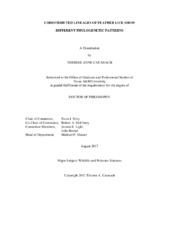| dc.description.abstract | Recent molecular phylogenies have suggested that hawks (Accipitridae) and falcons (Falconidae) form 2 distantly related groups within birds. Avian feather lice have often been used as a model for comparing host and parasite phylogenies, and in some cases there is significant congruence between them. Using 1 mitochondrial and 3 nuclear genes, I inferred a phylogeny for the feather louse genus Degeeriella (which are all obligate raptor ectoparasites) and related genera. This phylogeny indicated that Degeeriella is polyphyletic, with lice from falcons and hawks forming 2 distinct clades. Falcon lice were sister to lice from African woodpeckers, while Capraiella, a genus of lice from rollers lice, was embedded within Degeeriella from hawks. This phylogeny showed significant geographic structure, with host geography playing a larger role than host taxonomy in explaining louse phylogeny, particularly within clades of closely related lice. However, the louse phylogeny broadly reflects host phylogeny, for example Accipiter lice form a distinct clade.
Unlike most bird species, individual kingfisher species (Aves: Alcidae) are typically parasitized by 1 of 3 genera of lice (Insecta: Phthiraptera). These lice partition hosts by subfamily: Alcedoecus and Emersoniella parasitize Daceloninae whereas Alcedoffula parasitizes both Alcedininae and Cerylinae. While Emersoniella is geographically restricted, Alcedoecus and Alcedoffula are widespread. I used 2 molecular markers, the nuclear gene EF-1α and mitochondrial gene COI to infer phylogenies for both widespread genera of kingfisher lice, Alcedoffula and Alcedoecus. Additinally, I combined published host records with new host records reported here and used ancestral state reconstruction to identify patterns of host parasitism. Lastly, I compared louse phylogenies to host phylogenies to reconstruct their cophylogenetic history. I determined there are 2 distinct clades within Alcedoffula, 1 infesting Alcedininae, and the other infesting Cerylinae. Ancestral state reconstruction of kingfisher lice across the kingfisher phylogeny showed Alcedoecus and Emersoniella parasitize distinct clades within the kingfisher subfamily Daceloninae, and a single host switch by Alcedoecus onto the portion of the Daceloninae clade, which typically hosts Emersoniella. Cophylogenetic analysis indicated that although Alcedoecus and the lineage of Alcedoffula occurring on Alcedininae did not show evidence of cospeciation, the lineage of Alcedoffula occurring on Cerylinae showed strong evidence of cospeciation.
The chewing louse genus Colpocephalum parasitizes nearly a dozen distantly related orders of birds. Such a broad host range is uncommon among lice. However, the monophyly of the genus Colpocephalum with respect to a group of morphologically similar genera has never been tested. Using 1 nuclear and 1 mitochondrial gene, I inferred a phylogeny for 54 lice sampled from across the Colpocephalum-complex. The resulting phylogeny demonstrates several lineages were restricted to single host orders. These lineages corresponded to previously described genera. Maddison-Slatkin tests were performed on the resulting phylogeny and showed that host order, host family, and biogeographic region had significant phylogenetic signals when mapped onto the Colpocephalum-complex phylogeny. A PARAFIT analysis comparing the overall Colpocephalum-complex phylogeny to a host phylogeny revealed significant congruence between host and parasite trees. I also compared the cophylogenetic history of Colpocephalum and their hosts to that of a second distantly related feather louse genus, Degeeriella, which also infests diurnal birds of prey. Using PARAFIT to identify individual host-parasite links that contributed to overall congruence, I found no evidence of correlated cophylogenetic patterns between these 2 lice groups, which suggested that their distribution patterns were shaped by divergent evolutionary processes. | en |


